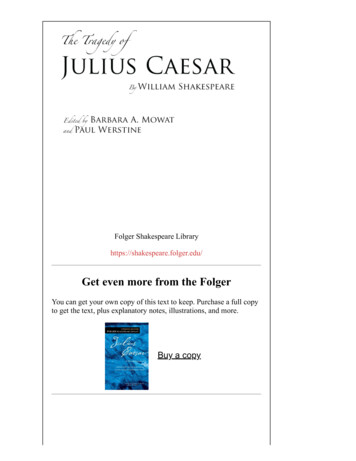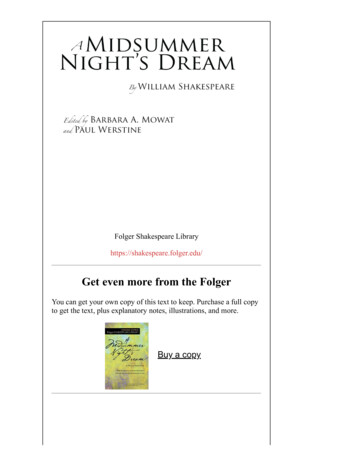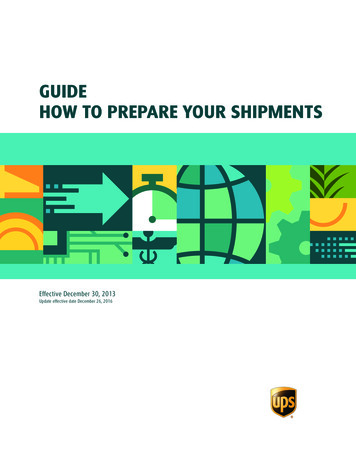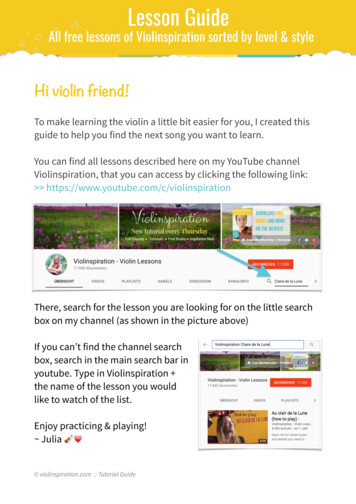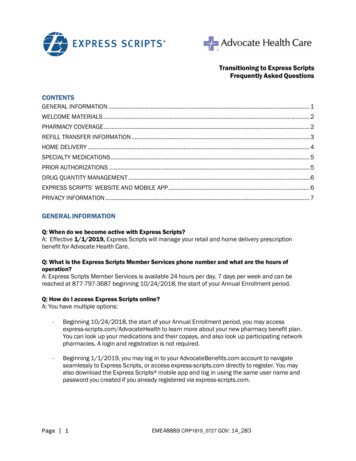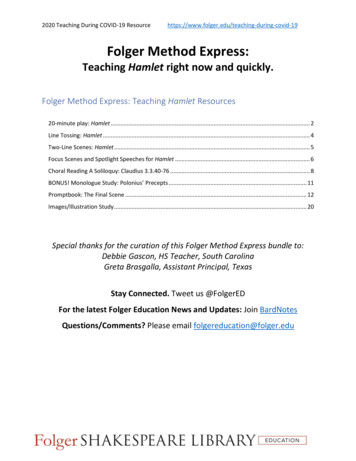
Transcription
2020 Teaching During COVID-19 id-19Folger Method Express:Teaching Hamlet right now and quickly.Folger Method Express: Teaching Hamlet Resources20-minute play: Hamlet . 2Line Tossing: Hamlet . 4Two-Line Scenes: Hamlet . 5Focus Scenes and Spotlight Speeches for Hamlet . 6Choral Reading A Soliloquy: Claudius 3.3.40-76 . 8BONUS! Monologue Study: Polonius’ Precepts . 11Promptbook: The Final Scene . 12Images/Illustration Study . 20Special thanks for the curation of this Folger Method Express bundle to:Debbie Gascon, HS Teacher, South CarolinaGreta Brasgalla, Assistant Principal, TexasStay Connected. Tweet us @FolgerEDFor the latest Folger Education News and Updates: Join BardNotesQuestions/Comments? Please email folgereducation@folger.edu
2020 Teaching During COVID-19 id-1920-minute play: HamletWHY DO THIS ACTIVITY? Giving students the plot upfront frees them up to focus on themost important thing: the language! Twenty-minute plays also get students workingcollaboratively in high-energy, low-stakes groups to own bite-size language from the play. Rightfrom the start, students develop a sense of ownership over the words and their ability to interpretthem for themselves. This essential practice lays the foundation for what’s ahead!HOW TO DO THIS ACTIVITY? Assign each student a line to practice. If you want to givethis to them a day before for them to practice or get props, that is an option. When having a classvideo meeting, the teacher reads the narrator part and then calls on the number for the line. Thestudent then says the line (with props or not). Afterward, use the chat feature to have studentsshare some of the lines that were memorable/questionable/interesting. Have students begin tocreate the plot through what they remember. You can also have teams of students write a plotsummary with quotations if your class has already started the play. It’s important to keep thesummary very short and simple—otherwise, there is too much narrative in proportion toperformed quotations.Once upon a time at Elsinore Castle, there was a lot happening. Let's start at the verybeginning, the very first line of the play. [1. WHO'S THERE?] We find that it's very quietat Elsinore Castle. [2. NOT A MOUSE STIRRING.] Things are not good. [3. SOMETHING ISROTTEN IN THE STATE OF DENMARK.] It's eerie, things aren't quite right. There areproblems and mysteries afloat. Someone has seen a ghost, and we also hear about a [4.MURDER!]Soon into this play, you meet the main characters. Probably the most important one [5.IT IS I! HAMLET THE DANE!] Then you meet his mother -- Gertrude -- as well as the evilstepfather Claudius, Polonius, Laertes, and other members of the court. We learn thatLaertes is going abroad, and we hear him get some advice from his old man, Polonius.[6. NEITHER A BORROWER NOR A LENDER BE.] At Claudius' invitation, two schoolfriends of Hamlet's join the court. [7. THANKS ROSENCRANTZ AND GENTLEGUILDENSTERN. THANKS GUILDENSTERN AND GENTLE ROSENCRANTZ.] We also meetOphelia, Hamlet's love interest, to whom Hamlet says: [8. I DID LOVE YOU -- ONCE.]
2020 Teaching During COVID-19 id-19Players come to the Castle -- people watched plays instead of getting online or playingvideo games -- and Hamlet welcomes them. [9. THEN CAME EACH ACTOR ON HIS ASS.]They put on a little play at court, which Hamlet is using to try and nail Claudius for themurder of Hamlet's father. During the play, Gertrude says: [10. THE LADY DOTHPROTEST TOO MUCH METHINKS.] And Claudius says: [11. GIVE ME SOME LIGHT!AWAY!]After the play, Hamlet goes to his mother's closet, which is what Shakespeare calls abedroom. He sees some movement behind the arras, which is what Shakespeare calls acurtain. Hamlet says [12. HOW NOW, A RAT!] Hamlet kills Polonius. And then he says[13. I'LL LUG THE GUTS INTO THE NEIGHBOR ROOM.] And still he has some advice forhis mother. [14. GOOD NIGHT, BUT GO NOT TO MINE UNCLE'S BED.]In the meantime: Ophelia begins to act strangely, goes mad, and drowns. [15. SWEETSTO THE SWEET! FAREWELL!] And Laertes is back, he's furious, and Claudius usesLaertes' fury to get rid of Hamlet. He arranges for a duel.Look for a poison sword and a poison cup somewhere here. [16. A HIT! A VERYPALPABLE HIT!] Gertrude drinks the wrong cup, and she dies. [17. LOOK TO THE QUEEN!HO!] Hamlet stabs Laertes, and as he dies, he identifies the real culprit. [18. THE KING.THE KING'S TO BLAME!] And Horatio winds up the action. [19. GOOD NIGHT, SWEETPRINCE, AND FLIGHTS OF ANGELS SING THEE TO THY REST.]And that's Hamlet!
2020 Teaching During COVID-19 id-19Line Tossing: HamletWHY DO THIS ACTIVITY? This essential activity helps students connect with the languagein a quick and active way. By engaging in Shakespeare’s words in an active and experientialway, students will come to own the lines and deepen the readings and interpretations of the text.This activity scaffolds the language and serves as a bridge to the language of longer, morecomplex excerpts of the text.HOW TO DO THIS ACTIVITY? Give students different lines to read aloud. You can assignthem before your video class meeting or just randomly put them into the chat and call onstudents to say the line. You can use tone words to have students say the line with different tonesand explore the change in meaning. Have students predict where the lines fit into the plot yousketched out from the 20-minute version.Who’s there?What dost thou mean by this?Well said, old mole.The devil take thy soul!You are a fishmonger.I will not speak with her!Aboard, aboard, for shame!Alack, what noise is this?Give they thoughts no tongue.O heat, dry up my brains.Get thee to a nunnery.This is mere madness.Man delights not meWhy, what a king is this!O, I am slain!He’s fat and scant of breath.O, speak to me no more!I’ll hit him now.Alas, he’s mad.For this relief much thanks.Do not look upon me.Sweets to the sweet.Hail, King! For so thou art.The time is out of joint.
2020 Teaching During COVID-19 id-19Two-Line Scenes: HamletWHY DO THIS ACTIVITY? Similar to line tossing, two-line scenes help students connectwith the language in a quick and active way. Not only does this essential get a line fromShakespeare into a student’s mouth, but it also gets that student interacting with anotherclassmate.HOW TO DO THIS ACTIVITY? If you can use a breakout feature, assign students to do twoline scenes with one another. Each student takes a line and connects it with the other line tocreate a short scene. Students must read their lines with feeling and should add gestures and/ormovement. Another option is to assign two-lines to each student and have them work withsomeone at home (a family member, puppet, pet, avatar) to create the scene.*Use lines from the line tossing activity in addition to the ones belowWhither wilt thou lead me? Speak. I’ll go no further.O day and night, but this is wondrous strange.Stay! Speak! Speak! I charge thee, speak!These are but wild and whirling words, my lord.Most humbly do I take my leave, my lord.Something is rotten in the state of Denmark.O, my lord, my lord, I have been so affrighted!O, there has been much throwing about of brains.I’ll lug the guts into the neighbor room.O, from this time forth / My thoughts be bloody, or be nothing worth!I prithee take thy fingers from my throat,I will fight with him upon this theme / Until my eyelids will no longer wag.His purse is empty already; all’s golden words are spent.Give me your pardon, sir. / I have done you wrong.
2020 Teaching During COVID-19 id-19Focus Scenes and Spotlight Speeches for HamletWHY DO THIS? The focus scenes and spotlight speeches below offer a rich environment forthe studying of characters, literary terms, motifs, and, most importantly, the language. Thesescenes can be assigned to be read with an audio version and can be supplemented with video aswell. After students read the scenes, they can response to teacher-created questions (these woulddepend upon the grade/levels you teach and your focus).HOW TO DO THIS? Some options include: 1) Have students preview the scene and thenassign parts in your whole group meeting. Read aloud and have questions in the chat. 2) Havestudents read then watch the Folger Theatre Macbeth performance. Then, choose selected partsof the scene to read aloud as a group. Use the chat box or discussion time to focus on specificstudent objectives. 3) Assign different groups to discuss each scene. They should have notesprepared and will run the classroom conference/chat feature. The spotlight speeches can be donesynchronously or asynchronously. Students can annotate and share their annotations or write in agroup document.ACT 11.2.1-16: Claudius announces he has married the Queen1.2.68-124: Gertrude tells Hamlet to embrace his new family1.2.190-end: Horatio and the guards tell Hamlet about the Ghost1.5.14-98: The Ghost tells his story. This scene could be used for the Promptbookby having student recreate what happened to the late King.Spotlight Speeches: Polonius gives lots of advice. Have students come up withtheir own precepts/advice for surviving senior year, surviving quarantine, etc. Polonius’ Precepts 1.3.65-87ACT 22.2.547-573: Hamlet asks the Players to perform a play similar to the killing ofHamlet’s fatherACT 33.1.64-162: Hamlet and Ophelia are spied upon3.2.145-155: The Dumb Show of The Mousetrap. This scene could also be usedfor the Promptbook by having students recreate how the play would be done forthe most drama.
2020 Teaching During COVID-19 id-193.3.40-103: Hamlet finds Claudius praying3.4.11-33: Polonius is killedSpotlight Speeches: Use the Folger’s Teaching During COVID19 page to havestudent create a mashup of Hamlet’s famous soliloquy. Hamlet 3.1.64-96: “To be or not to be ” Claudius’ prayer 3.3.40-76: This is an excellent choice for Choral Reading!Groups read every other line to see how Claudius justifies his actions (splitspeech version).ACT 44.7.146-end: Laertes and Claudius plan; Gertrude delivers news of Ophelia’sdeathAct 55.1.230-289: Hamlet declares his love for Ophelia5.2.268-end: The massacre
2020 Teaching During COVID-19 id-19Choral Reading A Soliloquy: Claudius 3.3.40-76WHY DO THIS? Soliloquies are full of possibilities. Getting students inside a soliloquy canlead to all kinds of deep reading and surprising discoveries about the words, characters, and bigquestions of the play. Choral reading a soliloquy provides students with an opportunity to buildthe understanding of the speech and to get to know the style and language of the speech.HOW TO DO THIS? Have students read aloud Claudius’ “My Offense is Rank” soliloquy,switching readers at the punctuation marks, including commas. Continue until the class has readthe entire speech. Then, divide the class into two groups: a Claudius group and a King group.Have one group read the part of Claudius, and the other group read the part of the King. Discusswhat happened when they read it chorally. How did the meaning change? Was there moreemotion? Did they understand better when they read it chorally? What words did they stress as agroup that weren’t stressed when they read as individuals? Did the tone change?
2020 Teaching During COVID-19 ResourceLines for Claudius and King Choral d-19
2020 Teaching During COVID-19 id-19
2020 Teaching During COVID-19 id-19BONUS! Monologue Study: Polonius’ PreceptsWHY DO THIS? This is an opportunity to hold a discussion with your students about the valuesof the characters in Hamlet as well as the values of their own modern-day community.HOW TO DO THIS? Have students read and annotate the text (can be done in pairs). Afterreading and annotating, discuss Polonius’ values and what he is grooming Laertes to value. Afterreading this scene you can also have students compare Polonius’ advice to Laertes with hisadvice to Ophelia. Then, have students write their own precepts. Students can write theirprecepts in plain English but should use as few words as possible. Make sure there is wit in theirprecept (brevity is the soul of wit, after all!).Ideas for student precepts: Have seniors write precepts to the freshmen or to future students of your class. Thiswould be a great way to establish classroom norms or expectations. Have students write precepts about the school or classroom. Students can write abouthow important homework or building a positive relationship with teachers is. I suggested to a colleague who teaches special needs students who are in wheelchairs tohave them write precepts about wheelchair etiquette. Ideas includes when to offer help tosomeone in a wheelchair and when not.
2020 Teaching During COVID-19 id-19Promptbook: The Final SceneWHY DO THIS? Creating a promptbook is a form of annotation. It encourages students to do aclose reading of a longer scene or passage and identify the big ideas, tone, and characterization.This scene has students analyze how to move several actors onstage to be the most effective.HOW TO DO THIS? Have students create a GoogleDoc by pasting the text on the left and thenputting production notes on the right side or by using the comments feature. You can also havestudents use Flipgrid or TikTok to show what the scene might look like. Students can then view avideo version after creating their own promptbooks to compare.
2020 Teaching During COVID-19 id-19
2020 Teaching During COVID-19 id-19
2020 Teaching During COVID-19 id-19
2020 Teaching During COVID-19 id-19
2020 Teaching During COVID-19 id-19
2020 Teaching During COVID-19 id-19
2020 Teaching During COVID-19 id-19
2020 Teaching During COVID-19 id-19Images/Illustration StudyWHY DO THIS ACTIVITY: Providing images to the students helps them see the characters inthe play, envision the scenes, determine tone, mood, power, emotion by making connectionsbetween the language and the images, and also to help with interpretations of the play or analyzeother possible interpretations of scenes. The visuals can be a jumping off point for students tostart thinking about the play, an extension of a scene, or a post-reading discussion about the play.HOW TO DO THIS ACTIVITY: There are many options to use the images with students. Askstudents to: Match lines from the play with an image (can use Google doc, Padlet or Adobe Spark)Put images in order of the plot of the playWrite a tone and/or mood word(s) that they feel is implied in the imageAnalyze the power in the scene: who has the power? Who is dominant? How can youtell? Justify.Analyze the clothing choices in the image. What do they imply? Look at the colors theartist chose (white? Sign of purity?) and justify why the artist made those decisions.If you’re also doing a vocab study, have students label the scene with vocab wordsCompare two similar scenes, such as the tomb scenes. How are they the same? Different?Why? What effects do these differences have on the feeling the image evokes?Create a tableaux of the scene with objects from around their home (similar to what theMet is doing on Instagram). Can be with people, pet, food, furniture.the sky is the limit!Create a hashtag to go with the image (the feelings, the mood, the tone)Create a conversation the characters are having that is NOT in the playExamine how love or hate or family (or whatever motif you want to discuss) is portrayedin the image. Is it through physical touch? Eye glances? Body language? Really LOOK atthe image and decide how they are “speaking” with no words on the page.Sketch the scene that comes before or after the image you share with the class.Watch Corinne Viglietta’s activity in the April 8th Zoom meeting about how you coulduse the images via ZoomHow to get the images from Luna, the Folger’s image database:1. Go to luna.folger.edu.2. Search in the top right for whatever you are searching for--I dida broad search of Romeo and Juliet.3. You can click Explore and look at media groups which arefolders where people have already sorted and curated images.4. When you find an image you want to use, click on it. You willsee in the top right a button that says EXPORT. Click that andchoose to export it how you wish (I exported the ones in thisdoc as small images. They will download to your Downloadsfolder (most likely in a zipped folder). Click that folder and theimages are in there ready to use.
2020 Teaching During COVID-19 id-19Ramberg, Johann Heinrich. Hamlet, IV, 7, Ophelia Falling intothe Water. 1829. Folger Shakespeare Library Collection,Washington, DC. LUNA - Folger Digital Image Collection. Web.4 Dec. 2015.Egley, William. [Original Sketch by William Egley for HisPainting of "Hamlet and Ophelia"]. Early-Mid 19th Century.Folger Shakespeare Library Collection, Washington, DC.LUNA - Folger Digital Image Collection. Web. 4 Dec. 2015.Cowper, Max. [Hamlet as Performed at the Adelphi Theatre]Ophelia, Lily Brayton, Hamlet, H.B. Irving, Act III, Scene 1,Hamlet: "Get Thee to a Nunnery, Why Would'st Thou Be aBreeder of Sinners?" 1905. Folger Shakespeare LibraryCollection, Washington, DC. LUNA - Folger Digital ImageCollection. Web. 4 Dec. 2015.
2020 Teaching During COVID-19 id-19Buchel, Charles A. Hamlet III, 20 century Folger Shakespeare LibraryCollection, Washington D.C. LUNA - Folger Digital Image Collection.thWeb. 4 Dec. 2015.Smyth, Coke. [Scenes from Hamlet and All's Well]. 19thCentury. Folger Shakespeare Library Collection,Washington, DC. LUNA - Folger Digital Image Collection.Web. 4 Dec. 2015.NY, Byron. Hamlet [5 Photographs of a ProductionStarring Edmund Russell as Hamlet, Miss JaneSchenck as Ophelia, Miss Louise Morewin asGertrude and William Hazeltine as Claudius]. 1903.Folger Shakespeare Library Collection, Washington,DC. LUNA - Folger Digital Image Collection. Web. 4Dec. 2015.
synchronously or asynchronously. Students can annotate and share their annotations or write in a group document. ACT 1 1.2.1-16: Claudius announces he has married the Queen 1.2.68-124: Gertrude tells Hamlet to embrace his new family 1.2.190-end: Horatio and the guards tell Hamlet about the G
